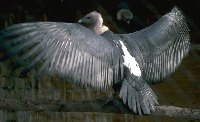-Shivani Thakur
 Vultures have been part of our culture from time immemorial. The famous "Jatayu"of the epic Ramayana who gives up his life trying to save Sita from clutches of Ravana belonged to the vulture family. Or the cunning creatures in the
animated version of The Jungle Book by Walt Disney, were also vultures. Vultures have been appraised as well as looked down upon by mankind. Their small heads devoid of any feathers, in comparison to their bulky bodies scavenging on dead are frowned upon by
old and feared by young.
Vultures have been part of our culture from time immemorial. The famous "Jatayu"of the epic Ramayana who gives up his life trying to save Sita from clutches of Ravana belonged to the vulture family. Or the cunning creatures in the
animated version of The Jungle Book by Walt Disney, were also vultures. Vultures have been appraised as well as looked down upon by mankind. Their small heads devoid of any feathers, in comparison to their bulky bodies scavenging on dead are frowned upon by
old and feared by young.
In India there are over 10 species of vultures. Of these the three most common are the Indian White- backed Gyps bengalensis, Indian Long-billed Gyps indicus and Slender-billed Gyps tenurostris. These three are also on the Schedule 1
of The Wildlife Protection Act. The reason behind this is their declining population.
Vultures feed on carcasses. The animals are dosed with veterinary Diclofenac, a standard painkiller. The diclofenac converts into large amount of uric acid, which larger animals can withstand safely. But in vultures causes toxic anal failure also known as "drooping
neck syndrome". This has resulted in a sharp decline of vulture population by over 97% from 1992 to 2003.
The Bombay Natural History Society (BNHS)first conducted its study at the Keoledeo National Park whereupon the rate of decline in Indian white backed vultures was 99.7% A study conducted by Dr.Rhys Green of the Royal society for the
protection of Birds indicated the decline in India, Pakistan and Nepal due to diclofenac poisoning. The earlier theories of viral or bacterial diseases were ruled out after intensive examination of dead birds.
The concern for declining population has bothered not only the conservationists but also the Parsi community. The Parsi community depend upon birds of prey to dispose of dead bodies. In the Tower of death the bodies are exposed to natural
element, the sky. Earlier it happened speedily but because of fewer vultures the system is slowing. The environmental damage is also an area of concern. The absence of scavenger birds would result in the outbreak of TB, anthrax and foot and mouth disease.
Vultures will be replaced by less favoured scavengers like rats and dogs. Diseases spread by them have become rampant in India.
The good news is that Natonal Board for Wildlife chaired by Prime Minister Dr. Manmohan Singh on March 17 2005 approved the phasing out of this painkiller and replacing it with non- lethal substitutes. BNHS on its part has opened
a vulture captive care center ,on the footsteps of the captive breeding of Californian Condor, in Pinjore (Haryana) and plan two more centers in Himachal Pradesh and West Bengal. Till then we can take pride in the only wild habitat of these birds in Chitalayam
forests inside the Wayanad Wildlife Sanctuary in Kerala which is known as the Valley of vultures. The survival of these majestic birds is an example of least interference of humans as they feed on wild animals who have not been exposed to the painkillers.
But the question remains whether all these efforts would be in time to save them. Or is it too late, as Peregrine Fund has warned that "their loss has important economic, cultural and human health consequences".